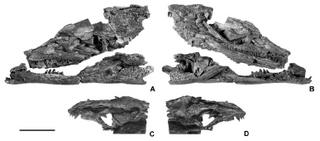Theriosuchus (Atoposauridae, Crocodylomorpha)

A new species of Theriosuchus (Atoposauridae, Crocodylomorpha) from the Late Jurassic (Kimmeridgian) of Guimarota, Portugal
Daniela Schwarz and Steven W. Salisbury
A new species of an atoposaurid crocodilian, Theriosuchus guimarotae, is described from the Late Jurassic (Kimmeridgian) of Portugal. Theriosuchus guimarotae can be distinguished from other species of Theriosuchus by a lateral surface of squamosal bevelled ventrally; a rounded, caudally projecting and dorsally sculptured caudolateral corner of the squamosal; a premaxillomaxillary suture aligned caudomedially in dorsal aspect; a minimum space between the supratemporal foramina that comprises one third of the total width of the cranial table; a minimum width of the frontal between the orbits that comprises one third of the maximum width of the skull at the orbits; a dentition that comprises only pseudocaniniform and lanceolate-shaped teeth; the presence of an external mandibular fenestra and all vertebral bodies amphicoelous. Its osteology also sheds light on the diagnosis of Theriosuchus within Atoposauridae.
The material additionally includes specimens representative of several ontogenetic stages, each of which is discussed here. With its Late Jurassic age, T. guimarotae represents the oldest well-preserved material of Theriosuchus and reveals further knowledge about the palaeobiogeography of the genus in western Europe.













<< Home